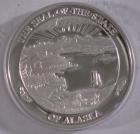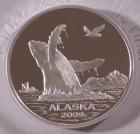2009 Alaska State Medallion - The Humpback Whale!


Contact for availability
Click either image to enlarge.
Production of the 2009 Humpback Whale stopped on December 31, 2009.
Total one ounce proof mintage: 2,725
Current List Price: $225.00
The one-ounce Official Alaska State Medallion Proof should be the first Alaska Medallion in any collection. It is made of .999 fine silver mined in the State of Alaska. Each medallion is rim stamped with an individual serial number. They come encased in an air tight holder with a velvet presentation box and information card.
The humpback whale (Megaptera novaeangliae) is the baleen whale most frequently seen swimming or feeding close to shore along the southern coast of Alaska. When beginning to dive, animals often lift their flukes (tail) out of the water thereby exposing the pattern of black and white which characterizes the ventral side. This pattern varies with each whale and is used by biologists to identify individual animals. Humpbacks may stay submerged for as long as 30 minutes although most dives do not last longer than 15 minutes. When resting near the surface between dives, whales may blow every few seconds.
General description: Humpback whales are distinguished from other whales by the extremely long flippers which may reach 25 to 30 percent of the length of the entire animal. The animals appear generally dark when viewed from above although the flippers may have varying amounts of white on the dorsal side. The underside of the flippers and tail, and often the sides and ventral surfaces of humpback whales may be partially white. Humpback whales have a small dorsal fin which is often seen when the animal is beginning to dive. Adults may reach a length of 55 feet (16.7 m) although the average adult length for west coast animals taken during the days of whaling was 42 feet (12.7 m) for females and 40.5 feet (12.3 m) for males. Like other baleen whales, adult females at any given age are usually larger than males. The plates of baleen are generally dark in color and number 270 - 400 on each side of the upper jaw.
Distribution and migration: Humpback whales occur throughout the world's oceans but they are not common in arctic waters. Although humpbacks may be seen at any time of year in Alaska, most animals undertake long distance migrations during the fall to temperate or tropical wintering areas where reproduction occurs and the young are born. During spring, the animals migrate back to Alaska where food is abundant. Humpback whales that summer in the north Pacific are from three separate stocks which winter in Mexico, in Hawaii, and in the western Pacific near the Mariana, Bonin, and Ryukyu islands. Whales that summer in Alaska are primarily from the Hawaii stock. Although the length of time needed to make migrations is not well known, one whale that was identified in Alaska was seen 39 days later in Hawaii 2,800 miles (4,500 km) away. When in Alaska, humpback whales tend to concentrate in several specific areas including Southeast Alaska, Prince William Sound, the area near Kodiak and the Barren Islands, the area between the Semidi and Shumagin Islands, and the eastern Aleutian Islands and southern Bering Sea.
The above is from The Alaska Department of Fish and Game
A Humpback Whale information sheet comes with each medallion.
